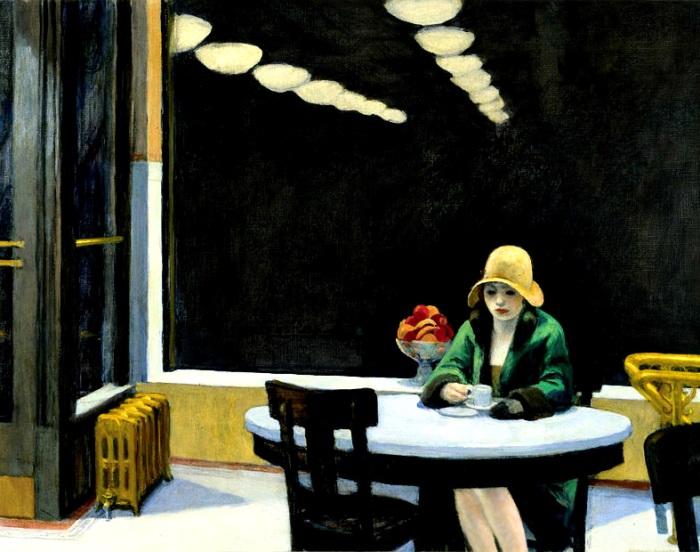I really appreciate Gergen’s approach
to thinking about modernism. The second chapter of his text, titled “From the
Romantic to the Modern Vision of Self,” positions modernism as a philosophical
view of life “in which reason and observation are the central ingredients of
human functioning” (19). Gergen situates modernism as the natural response to
romanticism. He views the movement as the rational delineation from a focus on
the “deep interior,” or the romantic idea that “the material world of the
senses is far less significant than the immaterial and unseen” (Gergen 26).
Instead, the focus of modernism is predicated on measurable phenomena and
realistic presentations of truth.
At the end of the nineteenth
century, such elements as industrial mass production and global conflict repositioned
thinking away from the introspection of the romantic era and into the practical
purview of modernism. Gergen points to progress in the sciences as the
foundation for modernism, citing improvements in medicine, sanitation, and
working conditions as catalysts for a western view of culture that moved away
from artifice and style and toward practicality and sincerity. Indeed, Gergen
refers often to the qualifiers “utilitarian” and “earnest” when he discusses
how modernism differs from both romanticism and the postmodern condition.
As support, he discusses music,
architecture, dance, and literature. He states:
In
the domain of dance, classical ballet was scorned for its decorative
formalisms, and the interpretive dance of the romantics seemed self-indulgent.
Dance turned “modern” when, in one critic’s words, it aimed to “externalize
personal, authentic experience.” (31)
I must pause here to provide full
disclosure. Gergen’s text champions the emotional and artistic attributes of
the romantic tradition, and he deeply admires the qualities of practicality and
sincerity that he views are the hallmarks of modernism. Indeed, his text and
its discussion of shifting personal identity views postmodernism as a cultural
threat that might “extinguish the validity of both the romantic and modern
realities” (19).
There are elaborate, methodical definitions for what we
commonly call postmodernism, and there are also some simplistic views:
Somewhere in the middle, as is
often the case, lies the truth. I think of postmodernism as a direct reaction
to the relatively staid tradition of modernism that preceded it. It is
exemplified by experimentation, reconstitution (what some scholars have come to
think of as remix culture), and adaptation. In his text The Electronic Word: Democracy, Technology, and the Arts, theorist
Richard Lanham provides an example that capably illustrates these traits. Lanham discusses technology as the great
facilitator of postmodernism. Like Gergen, he views “clarity” and
“authenticity” as the defining characteristics of modernism (25). He then proceeds
to discuss Marcel Duchamp’s mustachioed Mona
Lisa
(one of the artist’s “readymade” artifacts), making the argument that Duchamp’s
postmodern artistic efforts destabilize the aristocratic limits of modernism:
What
will emerge finally is a new rhetoric of the arts, an unblushing and unfiltered
attempt to plot all the ranges of formal expressivity now possible, however
realized and created by whom (or what-) ever. This rhetoric will make no
invidious distinctions between high and low culture, commercial and pure usage,
talented or chance creation, visual or auditory stimulus, iconic or alphabetic
information. (Lanham 24)
Lanham views postmodernism
positively, as an expressive and philosophical movement of the masses.
Postmodernism, in his view, levels the critical playing field and allows
greater participation via the various conduits of technology.
For visual purposes, I can
delineate between the movements by comparing the prairie-style architecture of prominent
Jacksonville, Florida, creator John Henry
Klutho
(a disciple of Frank Lloyd Wright, the father of organic architecture) with
that of noted postmodern architect Robert Venturi.


To further illustrate the point, consider the following portraits. Richard Barsam uses these paintings in a discussion of form and content in his excellent text Looking at Movies, but I think the lesson is applicable here as well. The Matisse portrait illustrates the transition between Fauvism and Modernism, and the latter is well represented by Edward Hopper’s work. The third work, a populist, minimalist piece, shows the human figure as I imagine a postmodernist would view it.
I believe the generalizations outlined in the textual and visual examples above have come to manifest themselves (to a material extent) in our present rhetorical situation. Obfuscation and artifice seem more in line with the argumentative and persuasive impulses of our politicized, postmodern present, while I personally cleave to the more authentic, sincere ethic that Gergen associates with modernism. Where modernism seems a movement born out of practical necessity, postmodernism seems more a product of “play,” a concept Lanham delves into with great precision in his text. There is room for both within the modern rhetorical tradition, of course, but the modern view strikes me as more useful in a philosophical consideration of reality.
Works
Cited
Gergen, Kenneth J. The Saturated Self: Dilemmas of Identity in Contemporary Life. New
York: Basic, 1991. Print.
Lanham, Richard. The Electronic Word: Democracy, Technology, and the Word. Chicago:
U of Chicago Press, 1993. Print.





No comments:
Post a Comment